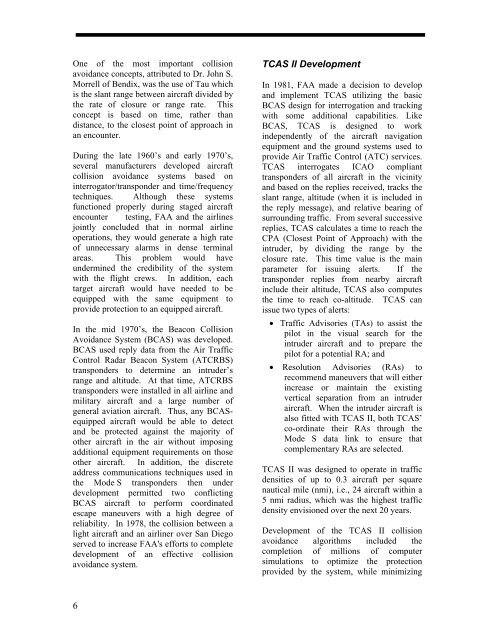You also want an ePaper? Increase the reach of your titles
YUMPU automatically turns print PDFs into web optimized ePapers that Google loves.
One of the most important collision<br />
avoidance concepts, attributed to Dr. John S.<br />
Morrell of Bendix, was the use of Tau which<br />
is the slant range between aircraft divided by<br />
the rate of closure or range rate. This<br />
concept is based on time, rather than<br />
distance, to the closest point of approach in<br />
an encounter.<br />
During the late 1960’s and early 1970’s,<br />
several manufacturers developed aircraft<br />
collision avoidance systems based on<br />
interrogator/transponder and time/frequency<br />
techniques. Although these systems<br />
functioned properly during staged aircraft<br />
encounter testing, FAA and the airlines<br />
jointly concluded that in normal airline<br />
operations, they would generate a high rate<br />
of unnecessary alarms in dense terminal<br />
areas. This problem would have<br />
undermined the credibility of the system<br />
with the flight crews. In addition, each<br />
target aircraft would have needed to be<br />
equipped with the same equipment to<br />
provide protection to an equipped aircraft.<br />
In the mid 1970’s, the Beacon Collision<br />
Avoidance System (BCAS) was developed.<br />
BCAS used reply data from the Air Traffic<br />
Control Radar Beacon System (ATCRBS)<br />
transponders to determine an intruder’s<br />
range and altitude. At that time, ATCRBS<br />
transponders were installed in all airline and<br />
military aircraft and a large number of<br />
general aviation aircraft. Thus, any BCASequipped<br />
aircraft would be able to detect<br />
and be protected against the majority of<br />
other aircraft in the air without imposing<br />
additional equipment requirements on those<br />
other aircraft. In addition, the discrete<br />
address communications techniques used in<br />
the Mode S transponders then under<br />
development permitted two conflicting<br />
BCAS aircraft to perform coordinated<br />
escape maneuvers with a high degree of<br />
reliability. In 1978, the collision between a<br />
light aircraft and an airliner over San Diego<br />
served to increase FAA's efforts to complete<br />
development of an effective collision<br />
avoidance system.<br />
<strong>TCAS</strong> <strong>II</strong> Development<br />
In 1981, FAA made a decision to develop<br />
and implement <strong>TCAS</strong> utilizing the basic<br />
BCAS design for interrogation and tracking<br />
with some additional capabilities. Like<br />
BCAS, <strong>TCAS</strong> is designed to work<br />
independently of the aircraft navigation<br />
equipment and the ground systems used to<br />
provide Air Traffic Control (ATC) services.<br />
<strong>TCAS</strong> interrogates ICAO compliant<br />
transponders of all aircraft in the vicinity<br />
and based on the replies received, tracks the<br />
slant range, altitude (when it is included in<br />
the reply message), and relative bearing of<br />
surrounding traffic. From several successive<br />
replies, <strong>TCAS</strong> calculates a time to reach the<br />
CPA (Closest Point of Approach) with the<br />
intruder, by dividing the range by the<br />
closure rate. This time value is the main<br />
parameter for issuing alerts. If the<br />
transponder replies from nearby aircraft<br />
include their altitude, <strong>TCAS</strong> also computes<br />
the time to reach co-altitude. <strong>TCAS</strong> can<br />
issue two types of alerts:<br />
Traffic Advisories (TAs) to assist the<br />
pilot in the visual search for the<br />
intruder aircraft and to prepare the<br />
pilot for a potential RA; and<br />
Resolution Advisories (RAs) to<br />
recommend maneuvers that will either<br />
increase or maintain the existing<br />
vertical separation from an intruder<br />
aircraft. When the intruder aircraft is<br />
also fitted with <strong>TCAS</strong> <strong>II</strong>, both <strong>TCAS</strong>’<br />
co-ordinate their RAs through the<br />
Mode S data link to ensure that<br />
complementary RAs are selected.<br />
<strong>TCAS</strong> <strong>II</strong> was designed to operate in traffic<br />
densities of up to 0.3 aircraft per square<br />
nautical mile (nmi), i.e., 24 aircraft within a<br />
5 nmi radius, which was the highest traffic<br />
density envisioned over the next 20 years.<br />
Development of the <strong>TCAS</strong> <strong>II</strong> collision<br />
avoidance algorithms included the<br />
completion of millions of computer<br />
simulations to optimize the protection<br />
provided by the system, while minimizing<br />
6



